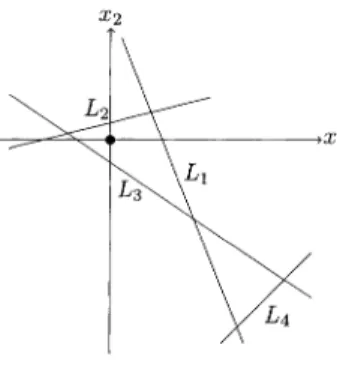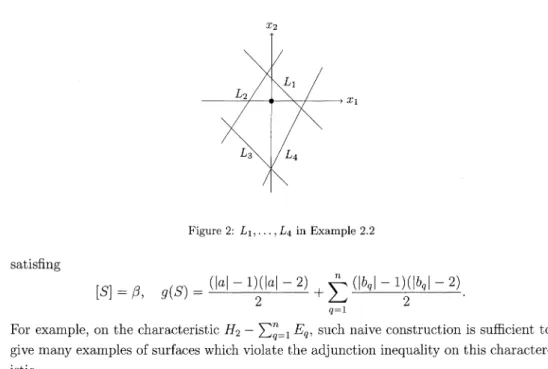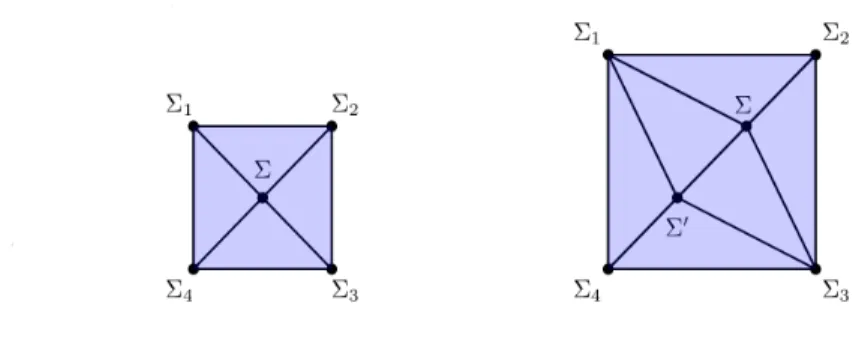A
family
of the
Seiberg‐Witten equations
and
configurations
of
embedded surfaces in 4‐manifolds
Hokuto Konno
Graduate School of Mathematical
Sciences,
the
University
of
Tokyo
Abstract
Inthispaperweconsider constraints onconfigurations consistingoffinitelymany surfacesem‐
bedded inanoriented closed 4‐manifold and its genera. Astudyofafamilyof theSeiberg‐Witten
equations,namely,the (high‐dimensionalwallcrossingphenomenonplaysaprominentrole inour
method. The results in§ 2arebasedon [3].
1
The
adjunction inequalities
and
configurations
of embedded
surfaces with
positive
intersection numbers
It is a fundamental
problem
in 4‐dimensionaltopology
tofind a lower bound for thegenus of an embedded surface which represents a
given
secondhomology
class of a 4‐dimensional manifold. This
problem
is often called the minimal genusproblem.
Forexample,
the minimalgenusproblem
for\mathbb{C}\mathbb{P}^{2}
is called the Thomconjecture
and this isone of themostclassical
problem
in4‐dimensionaltopology.
Gauge theory provides
strongtoolstoanswerthe minimal genusproblem
andacertaintype of
inequality
for genus obtainedby
gaugetheory
is often called theadjunction
in‐equality.
Hereweexplain
thisterminology.
Let X be acomplex
surface and C asmoothalgebraic
curveinX. Then it is easy toseethat the Euler characteristic$\chi$(C)=2-2g(C)
satisfies the
equality
- $\chi$(C)=c_{1}(X)\cdot C+C^{2},
where means the intersection number and
C^{2}=C\cdot C
. Thisequality
is called theadJunction
formula.
When X is a C^{\infty}4‐manifold and a surface $\Sigma$ is embeddedto XinC^{\infty}sense,
then,
ingeneral,
wecannotdetermineg( $\Sigma$)
by
thehomology
class[ $\Sigma$]
.However,
asurprising
observation in Kronheimer‐Mrowka[4]
isthat,
for a suitable characteristicc\in H^{2}(X;\mathbb{Z})
, one canexpecttheinequality
- $\chi$( $\Sigma$)\geq|c\cdot[ $\Sigma$]|+[ $\Sigma$]^{2}.
After
Seiberg‐Witten
theory appeared,
it issuccessfully
usedtostudy
the minimalgenusproblem.
Kronheimer‐Mrowka[5]
proved
the Thomconjecture
by using
theSeiberg‐
Wittenequations.
They
gavethe wallcrossing
formula for theSeiberg‐Witten
invariantsfor 4‐manifolds with b^{+}=1 and usethis formula for the
proof
of the Thomconjecture.
Here
b^{+}(X)
is the maximal dimension ofpositive
definitesubspaces
ofH^{2}(X;\mathbb{R})
withrespect totheintersection form ofX.
The direct consequence ofarguments in Kronheimer‐Mrowka
[5]
is that the strongre‐lation between the
Seiberg‐Witten
invariants and theadjunction inequalities.
For anoriented,
closed smooth 4‐manifoldX withb^{+}(X)\geq 2
and aspin
\mathrm{c} structure\mathfrak{s} onX, let\mathrm{S}\mathrm{W}_{X}(\mathfrak{s})\in \mathbb{Z}
denote theSeiberg‐Witten
invariantofXwithrespect to\mathfrak{s}.(More
precisely,
we have to fix ahomology
orientation of X to determine thesign
of\mathrm{S}\mathrm{W}_{X}(\mathfrak{s})
. Here ahomology
orientation ofX means an orientationofH^{0}(X;\mathbb{R})\oplus H^{1}(X;\mathbb{R})\oplus H^{+}(X;\mathbb{R})
,where
H^{+}(X;\mathbb{R})
is a b^{+}‐dimensionalpositive
definitesubspace
ofH^{2}(X;\mathbb{R}
In thispaper, we consider
only
surfaces which areoriented,
closed and connected. Put$\chi$^{-}( $\Sigma$):=\displaystyle \max\{- $\chi$( $\Sigma$), 0\}
for asurface $\Sigma$.Theorem 1.1.
(Kronheimer‐Mrowka [5])
LetX be anoriented,
closed smooth4‐manifold
with
b^{+}(X)\geq 2
and $\Sigma$ beasurface
embeddedin X with[ $\Sigma$]^{2}\geq 0
. Lets be aspin
cstructurewith
\mathrm{S}\mathrm{W}_{X}(\mathfrak{s})\neq 0
.Then,
theinequality
$\chi$^{-}( $\Sigma$)\geq|c_{1}(\mathfrak{s})\cdot[ $\Sigma$]|+[ $\Sigma$]^{2}
holds.
However,
there are many 4‐manifolds whoseSeiberg‐Witten
invariants vanish. Forex‐ample,
theSeiberg‐Witten
invariants for 4‐manifolds obtainedby
connected sum vanishunder mild
assumptions
on b^{+}: letX_{i}(i=1,2)
beoriented,
closed 4‐manifolds withb^{+}(X_{i})\geq 1
, then\mathrm{S}\mathrm{W}_{X_{1}\# X_{2}}(\mathfrak{s})=0
for anyspin
\mathrm{c} structure \mathfrak{s} onX_{1}\# X_{2}
. Thereforewe cannot usethe
Seiberg‐Witten
invariant to show theadjunction inequalities
for such4‐manifolds. In
fact,
Nouh[7]
proved
that theadjunction inequality
for a surface in\mathbb{C}\mathbb{P}^{2}\#\mathbb{C}\mathbb{P}^{2}
does not holdingeneral.
Nouhs result showsthat,
for such4‐manifolds,
notonly
does one cannotuse theSeiberg‐Witten
invariants,
but also one mayfindexamples
of surfaces which violate the
adjunction
inequalities.
Thus anatural
question
iswhenone canshowtheadjunction inequality
for 4‐manifoldswhose
Seiberg‐Witten
invariants vanish. In Strles paper[12],
he showed thefollowing
adjunction inequalities
fordisjoint
embeddedsurfaces withpositive
self‐intersectionnum‐Theorem 1.2.
(Strle [12])
LetX beanoriented closed smooth4‐manifold
withb_{1}(X)=0
andc\in H^{2}(X;\mathbb{Z})
be a characteristic withc^{2}>\mathrm{s}\mathrm{i}\mathrm{g}\mathrm{n}(X)
.(A)
In the caseof
b^{+}(X)=1
, let$\alpha$\in H_{2}(X;\mathbb{Z})
be ahomology
class with$\alpha$^{2}>0
and $\Sigma$\subset X be an embeddedsurface
with[ $\Sigma$]= $\alpha$
. Then theinequality
- $\chi$( $\Sigma$)\geq-|c\cdot $\alpha$|+$\alpha$^{2}
(1)
holds.
(B)
In the caseof
b^{+}(X)>1
, let $\alpha$_{1},. ..,
$\alpha$_{b+}\in H_{2}(X;\mathbb{Z})
behomology
classes with$\alpha$_{i}^{2}>0(1\leq i\leq b^{+})
and$\Sigma$_{1}
,... ,$\Sigma$_{b+}\subset X
be embeddedsurfaces
with[$\Sigma$_{i}]=$\alpha$_{i}.
Assume that
$\Sigma$_{1}
,.. .,$\Sigma$_{b+}
aredisjoint.
Then theinequality
- $\chi$($\Sigma$_{i})\geq-|c\cdot$\alpha$_{i}|+$\alpha$_{i}^{2}
(2)
holds atleast onei\in\{1, . . . , b^{+}\}.
Note that Strles theoremcanbe
applied
to4‐manifolds whoseSeiberg‐Witten
invariantsvanish. His result suggests that one can expect some constraints on
configurations
ofembedded surfacesina 4‐manifold evenwhen its
Seiberg‐Witten
invariant vanishes. In therestof thispaper, wewillexplain
twoconstraintsonconfigurations
of embeddedsurfaces with self‐intersection number zero. Our constraints can be also
applied
to 4‐manifolds whose
Seiberg‐Witten
invariantsvanish. While Strlesproof
standson astudy
of the moduli space of the
Seiberg‐Witten equations
on a 4‐manifold withcylindrical
ends,
ourmethod is tostudy only
compact 4‐manifolds and use thehigh‐dimensional
wall
crossing
phenomena.
InSeiberg‐Witten
theory,
the wallcrossing phenomena
areusually
studied in the case when b^{+}=1. Li‐Liu[6]
gave itsgeneralizations
for anyb^{+}. While in the usual wall
crossing
phenomena
a1‐parameter
family
of theSeiberg‐
Witten
equations
is the mainobject,
in Li‐Liu[6]
s situation a b^{+}‐parameterfamily
isit. We call Li‐Liu
[6]
sgeneralizations
thehigh‐dimensional
wallcrossing phenomena.
Touse the
high‐dimensional
wallcrossing
phenomena
for constraints onconfigurations,
in[3]
the author gave a sufficient condition on a certain b^{+}‐parameterfamily
to catch thehigh‐dimensional
wallcrossing
phenomenon
in terms of embedded surfaces. This is the foundation of theproof
ofthe results inthispaper.Figure1: Anexampleofaquadrilateral includingtheoriginof\mathbb{R}^{2}
2
Constraints
onconfigurations
obtained
by
the
high‐dimensional
wall
crossing phenomena
Inthis
section,
weexplain
aspecial
caseof the result obtainedby
thehigh‐dimensional
wall
crossing phenomena,
namely,
theadjunction inequalities
forconfigurations
ofsurfacesin
2\mathbb{C}\mathbb{P}^{2}\# n(-\mathbb{C}\mathbb{P}^{2})
. For ageneralization
of thisresult,
see[3]. (From
thegeneral
form of ourresults,
we cangive
asimple
alternativeproof
of Strles results: Thoerem1.2.)
Wewill oftenuse theidentification H^{2}
\simeq H_{2}
obtainedby
Poincaréduality.
Let consider the 4‐manifold
X=2\mathbb{C}\mathbb{P}^{2}\# n(-\mathbb{C}\mathbb{P}^{2})=(\#_{p=1}^{2}\mathbb{C}\mathbb{P}_{p}^{2})\#(\#_{q=1}^{n}(-\mathbb{C}\mathbb{P}_{q}^{2})) (n>0)
.Let
H_{p}
denote a generator ofH_{2}(\mathbb{C}\mathbb{P}_{p}^{2};\mathbb{Z})
andE_{q}
a generator ofH_{2}(-\mathbb{C}\mathbb{P}_{q}^{2};\mathbb{Z})
. For acohomology
classc\in H^{2}(X;\mathbb{Z})
andhomology
classes$\alpha$_{1},...,$\alpha$_{4}\in H_{2}(X;\mathbb{Z})
, we definealine
L_{i}(i=1, \ldots, 4)
in\mathbb{R}^{2}by
L_{i} :=\{(x_{1}, x_{2})\in \mathbb{R}^{2}|(x_{1}H_{1}+x_{2}H_{2})\cdot$\alpha$_{i}=c\cdot$\alpha$_{i}\}
.(3)
For these
lines,
we will consider the condition that(parts of)
linesL_{1}
,.. .,L_{4}
form sidesofa
quadrilateral by
this order. Herewe usethe word(quadrilateral
inthefollowing
sense. LetLí,
. .. ,L_{4}'
be four line segments in \mathbb{R}^{2}. Ifan orientation ofLí
isgiven,
we candefine the initialpoint
I(L_{i}')
and the terminalpoint
T(Lí)
ofLí.
We call the orderedset
(Lí,
.. .,
L_{4}')
aquadrilateral
when there exists an orientation for eachLí
such thatT(Lí)
=I(L_{i+1}')
holds for eachi\in \mathbb{Z}/4
.(We
admit apoint
as a linesegment.
Thus atriangle
alsoaquadrilateral
inourdefinition.)
Theorem 2.1. For the
4‐manifold
let
c\in H^{2}(X;\mathbb{Z})
be a characteristic withc^{2}>\mathrm{s}\mathrm{i}\mathrm{g}\mathrm{n}(X)
and $\alpha$_{1},. ..,$\alpha$_{4}\in H_{2}(X;\mathbb{Z})
behomology
classes with$\alpha$_{i}^{2}=0(i=1, \ldots, 4)
. Let$\Sigma$_{1}
,.. .,
$\Sigma$_{4}\subset X
be embeddedsurfaces
with
[$\Sigma$_{i}]=$\alpha$_{i}
. Assume that$\alpha$_{i} andcsatisfy
thefollowing
(A)
and$\Sigma$_{i}
satisfy
(B)
:(A)
The linesL_{1}
,... ,L_{4}
form
sidesof
aquadrilateral including
theorigin
of
\mathbb{R}^{2}by
thisorder.
(B) $\Sigma$_{i}\cap$\Sigma$_{i+1}=\emptyset(i\in \mathbb{Z}/4)
.Then,
theinequality
- $\chi$($\Sigma$_{i})\geq|c\cdot$\alpha$_{i}|
holdsfor
at least onei\in\{1
,...,4\}.
Example
2.2. LetX=2\mathbb{C}\mathbb{P}^{2}\# 19(-\mathbb{C}\mathbb{P}^{2})
,c=H_{1}-3H_{2}-\displaystyle \sum_{q=1}^{19}E_{q}
. Thehomology
classes$\alpha$_{1} :=3H_{1}+3H_{2}-\displaystyle \sum_{q=1}^{3}E_{q}+\sum_{q=4}^{10}E_{q}+2(E_{11}+E_{12})
,$\alpha$_{2} :=-3H_{1}+2H_{2}+\displaystyle \sum_{q=1}^{3}E_{q}+\sum_{q=13}^{18}E_{q}+2E_{19}
$\alpha$_{3}:=H_{1}+H_{2}+E_{12}-E_{13},
$\alpha$_{4} :=2H_{1}-H_{2}-\displaystyle \sum_{q=1}^{3}E_{q}-E_{13}+E_{14}
satisfy
that$\alpha$_{i}^{2}=0
and$\alpha$_{i}\cdot$\alpha$_{i+1}=0(i\in \mathbb{Z}/4)
. It is easy to check that these $\alpha$_{i} and csatisfy
(A)
inTheorem 2.1.(See
Figure
2.)
Thus,
by
Theorem2.1,
for embedded surfaces$\Sigma$_{i}
satisfying
[$\Sigma$_{i}]=$\alpha$_{i}
, ifthey
alsosatisfy
that$\Sigma$_{i}\cap$\Sigma$_{i+1}=\emptyset(i\in \mathbb{Z}/4)
,- $\chi$($\Sigma$_{i})\geq|c\cdot$\alpha$_{i}|
holds for at leastone
i\in\{1
,. ..,4\}
. Thismeans that thegenus boundg($\Sigma$_{i})\geq 2
holds for at leastonei\in\{1
,... ,4\}.
Undercertain
assumptions
ongeometric
intersectionswith embedded surfacesviolating
the
adjunction inequalities,
we can derive theadjunction inequality
for asingle
surface.Before
giving
anexample,
wementionaneasymethodtomakesurfaces with smallgenera.Fora
homology
class$\beta$=aH_{2}+\displaystyle \sum_{q=1}^{n}b_{q}E_{q}\in H_{2}(\mathbb{C}\mathbb{P}_{2}^{2}\# n(-\mathbb{C}\mathbb{P}^{2});\mathbb{Z})
,considering algebraic
curves
C\subset \mathbb{C}\mathbb{P}_{2}^{2}
andC_{q}\subset \mathbb{C}\mathbb{P}_{q}^{2}
andreversing
orientations of them ifweneed,
we caneasily
construct the surfaceS\subset \mathbb{C}\mathbb{P}_{2}^{2}\# n(-\mathbb{C}\mathbb{P}^{2})
by
Figure2: L_{1},...,L_{4}inExample2.2
satisfing
[S]= $\beta$, g(S)=\displaystyle \frac{(|a|-1)(|a|-2)}{2}+\sum_{q=1}^{n}\frac{(|b_{q}|-1)(|b_{q}|-2)}{2}.
For
example,
on the characteristicH_{2}-\displaystyle \sum_{q=1}^{n}E_{q}
, suchnaive construction is sufficient togive
manyexamples
of surfaces which violate theadjunction inequality
onthischaracter‐istic.
Example
2.3. Letgive
natural numbersd_{1}\geq 4, d_{2}\geq 1, d_{3}\geq 2
andn\displaystyle \geq d_{1}^{2}+\max\{d_{2}^{2}, d_{3}^{2}\}.
ForX=2\mathbb{C}\mathbb{P}^{2}\# n(-\mathbb{C}\mathbb{P}^{2})
,let consider thehomology
classes$\alpha$:=d_{1}H_{1}-\displaystyle \sum_{q=1}^{d_{1}^{2}}E_{q},
$\beta$_{1}:=d_{2}H_{2}+\displaystyle \sum_{q=d_{1}^{2}+1}^{d_{1}^{2}+d_{2}^{2}}E_{q},
$\beta$_{2}:=d_{3}H_{2}-\displaystyle \sum_{q=d_{1}^{2}+1}^{d_{1}^{2}+d_{3}^{2}}E_{q}.
Let
S_{i}\subset \mathbb{C}\mathbb{P}_{2}^{2}\# n(-\mathbb{C}\mathbb{P}^{2})\backslash (
disk)
\subset X be surfaces with[S_{i}]=$\beta$_{i}
obtained as(4).
Foranembedded surface $\Sigma$\subset X
satisfying
[ $\Sigma$]= $\alpha$
and$\Sigma$\cap S_{i}=\emptyset(i=1,2)
, we can show thatg( $\Sigma$)\displaystyle \geq\frac{(d_{1}-1)(d_{1}-2)}{2}
(5)
from Theorem 2.1.By
theadjunction
formula for\mathbb{C}\mathbb{P}_{1}^{2}\# n(-\mathbb{C}\mathbb{P}^{2})
,thehomology
class $\alpha$ canberepresented
by
asurface $\Sigma$ ofgenus(d_{1}-1)(d_{1}-2)/2
satisfying $\Sigma$\cap S_{i}=\emptyset
. Thus theinequality
(5)
3
Constraints
onconfigurations
obtained
by
the
high‐dimensional
wall
crossing phenomena
and the
gluing technique
To obtain the results in
§ 2,
the author used thehigh‐dimensional
wallcrossing phe‐
nomena in
[3].
On the otherhand,
Ruberman([8], [9]
and[10])
studied the combinationof the usual
(\mathrm{i}.\mathrm{e}. b^{+}=1)
wallcrossing
phenomena
and thegluing technique.
Thegluing
technique
is adeep analytical
tool in gaugetheory.
Atypical application
of thegluing
technique
istheproof
theblowup
formula,
which describes the behavior of theSeiberg‐
Witten invariants
(or
Donaldsoninvariants)
underblowups
of 4‐manifolds. Rubermansargumentscanbe
regarded
as a1‐parameter
version of theproof
of theblowup
formula.Namely,
Ruberman considered thegluing
argument astheproof
of theblowup
formula forthe
1‐parameter
family
touse the wallcrossing
argument. This argument can be gener‐alizedto
higher‐dimensional
familiestousethehigh‐dimensional
wallcrossing
argument.This
generalization gives
new constraints onconfigurations.
In thissection,
wegive
theformulation of these results.
To describe the
results,
for aspin
c4‐manifold,
we introduce an abstractsimplicial
complex
which consists of surfacesviolating
theadjunction
inequalities.
Before the defi‐nitionof this
simplicial complex,
weneedan (ambientsimplicial complex.
This ambientsimplicial complex
wasintroduced tothe authorby
Mikio Furuta.Definition 3.1.
(Furuta)
For anoriented,
closed 4‐manifold X, we define the abstractsimplicial complex
\mathcal{K}=\mathcal{K}(X)
asfollows:The set ofvertices
V(\mathcal{K})
isgiven
as the set of smoothembeddings
ofsurfaces withself‐intersection number zero:
V(\mathcal{K}):=\{ $\Sigma$\mapsto X|[ $\Sigma$]^{2}=0\}.
Here we consider
only oriented, closed,
connected surfaces. We denote each vertex( $\Sigma$\leftarrow+X)\in V(\mathcal{K})
briefly by
$\Sigma$.For
k\geq 1
, a collection of(k+1)
vertices$\Sigma$_{0}
,. ..,$\Sigma$_{k}\in V(\mathcal{K})
spans a k‐simplex
ifand
only
if$\Sigma$_{0}
,... ,$\Sigma$_{k}
aredisjoint.
Wecall \mathcal{K} the
complex of surfaces
of X.Ofcourse, anyabstract
simplicial complex
is a CWcomplex,
thus \mathcal{K}is a CWcomplex
although
\mathcal{K}isahuge
space.Wetopologize
\mathcal{K}as aCWcomplex, i.e.,
by
the weaktopology.
Remark3.2. The
complex
of surfacesis a4‐dimensionalanalog
of thecomplex
of curvesdue to
Harvey
[2]
in 2‐dimensionaltopology.
In the above definition of thecomplex
ofhand,
in the same way of the definition of thecomplex
ofcurves, one can define an ab‐stract
simplicial complex
whoseverticesaretheisotopy
classesofembeddings
of surfacesand whose
simplices
arespanned by
collections of suchisotopy
classes whichcan bereal‐ized
disjointly. However,
togive
certainapplications
to theadjunction inequalities using
Seiberg‐Witten theory,
the first definition of thecomplex
of surfacesmight
beappropriate.
Hereweconsider thespecial phenomena
in4‐dimensionaltopology, namely,
theadjunc‐
tion
inequalities.
Definition 3.3. Let\mathfrak{s}bea
spin
\mathrm{c}structureonX.Then,
thecomplex
of surfaces violating
the
adjunction inequality
\mathcal{K}_{V}=\mathcal{K}_{V}(X, \mathfrak{s})
is thesubcomplex
of\mathcal{K}(X)
definedas theset ofvertices is
given
by
V(\mathcal{K}_{V}):=\{ $\Sigma$\in V(\mathcal{K})|$\chi$^{-}( $\Sigma$)<|c_{1}(\mathfrak{s})\cdot[ $\Sigma$]|\}
and
having
the induced structure of an abstractsimplicial complex
from \mathcal{K}.Namely,
$\Sigma$_{0}
,... ,$\Sigma$_{k}\in V(\mathcal{K}_{V})
spans a k‐simplex
if andonly
if$\Sigma$_{0}
,. ..,$\Sigma$_{k}
spana k‐simplex
in \mathcal{K}.Let \mathrm{s}^{+} be a
spin
\mathrm{c}structure on\mathbb{C}\mathbb{P}^{2}
such thatc_{1}(\mathfrak{s}^{+})
isa generator inH_{2}(\mathbb{C}\mathbb{P}^{2};\mathbb{Z})
and\mathfrak{s}^{-} be a
spin
\mathrm{c} structureon-\mathbb{C}\mathbb{P}^{2}
such thatc_{1}(\mathfrak{s}^{-})
is a generatorinH_{2}(-\mathbb{C}\mathbb{P}^{2};\mathbb{Z})
.(We
havetwochoices of each\mathfrak{s}^{+} and\mathfrak{s}
The mainresult inthis section isthe
following
statement.Theorem 3.4. Let
(X, \mathrm{s}_{X})
be anoriented,
closedspin
c4‐manifold
withb^{+}(X)\geq 2.
Suppose
that\mathrm{S}\mathrm{W}_{X}(\mathfrak{s})\neq 0
andd(\mathfrak{s}_{X})=0
, whered(\mathrm{s})
:=(c_{1}(\mathfrak{s})^{2}-2 $\chi$(X)-3\mathrm{s}\mathrm{i}\mathrm{g}\mathrm{n}(X))/4.
PutZ:=X\# m\mathbb{C}\mathbb{P}^{2}\# n(-\mathbb{C}\mathbb{P}^{2}) (m\geq 1, n\geq 4m)
,\mathfrak{s}_{Z}:=\mathfrak{s}_{X}\#(\#_{p=1}^{m}\mathfrak{s}_{p}^{+})\#(\#_{q=1}^{n}\mathfrak{s}_{q}^{-})
.Then
\tilde{H}_{m-1}(\mathcal{K}_{V}(Z, \mathfrak{s}_{Z});\mathbb{Z})\neq 0
holds.
Remark 3.5. More
precisely,
wecangive
aconcretenon‐trivial element of\tilde{H}_{m-1}(\mathcal{K}_{V}(Z, \mathfrak{s}_{Z});\mathbb{Z})
.Toprove Theorem
3.4,
wedefine agrouphomomorphism
SW
=\mathrm{S}\mathrm{W}_{Z,\mathfrak{s}_{Z}}:\mathcal{H}_{*}(Z,\mathfrak{s}_{Z})\rightarrow \mathbb{Z}
and show that thismap isnon‐tivial. Here
\mathcal{H}_{*}(Z,\mathfrak{s}_{Z})
isacertainsubgroup
of\tilde{H}_{*}(\mathcal{K}_{V}(Z, \mathfrak{s}_{Z});\mathbb{Z})
.The mapSWis
defined, roughly speaking, by counting
theparametrized
modulispaceFigure3: Someboundingsfor $\gamma$
counting
argument, we useRuans virtualneighborhood
technique
anditsfamily
version.)
Thisparameterspaceisobtained
by stretching
neighborhoods
of embedded surfaces which forms the element of\mathcal{H}_{*}. Thisconstructionof theparameter
spaceis aslight
generaliza‐
tion ofonedueto\mathrm{F}\mathrm{r}\emptyset
yshov
[
1]
. Theproof
of thenon‐triviality
of this mapisgiven
by
thecombination of the
high‐dimensional
wallcrossing
phenomena
and thegluing
technique.
Here we
explain why
a non‐trivial element of\tilde{H}_{*}(\mathcal{K}_{V}(Z, \mathfrak{s}_{Z});\mathbb{Z})
is useful togive
con‐straintson
configurations
of embedded surfaces andits genera. Forexample,
let$\Sigma$_{1}
,... ,$\Sigma$_{4}\in
V(\mathcal{K}_{V})
be embedded surfaces with$\Sigma$_{i}\cap$\Sigma$_{i+1}=\emptyset(i\in \mathbb{Z}/4)
. Then the collection\{($\Sigma$_{i}, $\Sigma$_{i+1}\}\}_{i\in \mathrm{Z}/4}
formsa1‐cycle
$\gamma$=\{$\Sigma$_{1}, $\Sigma$_{2}\}+\cdots+\langle$\Sigma$_{4}, $\Sigma$_{1}\rangle
in\mathcal{K}_{V}
. Assume that[ $\gamma$]\neq 0
in
H_{1}(\mathcal{K}_{V};\mathbb{Z})
. For$\Sigma$\in V(\mathcal{K})
with$\Sigma$\cap$\Sigma$_{i}=\emptyset(i\in \mathbb{Z}/4)
,the collection\{\langle $\Sigma,\ \Sigma$_{i}, $\Sigma$_{i+1})\}_{i\in \mathbb{Z}/4}
can be
regarded
as the cone of this1‐cycle.
(See
Figure
3.)
If$\Sigma$\in V(\mathcal{K}_{V})
holds,
thiscone iscontainedin
\mathcal{K}_{V}
, thus[ $\gamma$]=0
inH_{1}(\mathcal{K}_{V};\mathbb{Z})
. This contradictsourassumption,
thereforewe have
$\Sigma$\not\in V(\mathcal{K}_{V})
. Inconclusion,
we have theadjunction inequality
for anembedded surface $\Sigma$ with
$\Sigma$\cap$\Sigma$_{i}=\emptyset(i\in \mathbb{Z}/4)
.Inthesame way,for embedded surface
$\Sigma$,
$\Sigma$'\in V(\mathcal{K})
,if $\Sigma$ and $\Sigma$' satisfies$\Sigma$\cap$\Sigma$_{i}=\emptyset(i=1,2,3) , $\Sigma$'\cap$\Sigma$_{i}=\emptyset(i=1,3,4) , $\Sigma$\cap$\Sigma$'=\emptyset,
then
$\Sigma$\not\in V(\mathcal{K}_{V})
or$\Sigma$'\not\in V(\mathcal{K}_{V})
holds.Namely,
theadjuction
inequality
holds for $\Sigma$ or$\Sigma$'.
(See
Figure
3.)
Asinthese
example,
ifwefindanon‐trivial elementinH_{*}(\mathcal{K}_{V};\mathbb{Z})
,weobtain constraintsongenerafor
infinitly
manyconfigurations
of surfaces.Acknowledgement.
The author wouldliketo express hisdeep
gratitude
to Mikio Furutafor thenumerouscommentsonthis work. The authorwas
supported by
JSPS KAKENHIReferences
[1] Kim A.\mathrm{F}\mathrm{r}\emptysetyshov, Aninequality forthe h ‐invariant in instanton Floertheory,Topology43(2004),no. 2,407‐432,
DOI 10.1016/\mathrm{S}0040-9383(03)00049-1 MR2052970(2005c:57043)
[2] W. J.Harvey, Boundarystructureofthemodulargroup, Riemannsurfacesand relatedtopics:Proceedingsof the 1978
StonyBrookConference(StateUniv.NewYork, Stony Brook,NY., 1978),Ann. of Math Stud.,vol.97,Princeton
Univ.Press, Princeton, N.J., 1981,pp. 245‐251. MR624817
[3] H.Konno,Boundsongenusandconfigurations ofembeddedsurfacesin4‐manifolds,available at arXiv: 1507. 00139.
[4] P. B. Kronheimer and T. S.Mrowka,Embeddedsurfacesand the structureofDonaldsonspolynomial invariants,\mathrm{J} Differential Geom. 41(1995),no.3,573‐734. MR1338483(96e:570l9)
[5] —, The genus ofembeddedsurfaces in theprojective plane,Math. Res. Lett. 1 (1994), no. 6, 797‐808, DOI
10.4310/\mathrm{M}\mathrm{R}\mathrm{L}.1994.\mathrm{v}1n6a14. MR1306022(96a:57073)
[6] Tian‐JunLiand Ai‐KoLiu, Family Seiberg‐Witten invariants andwallcrossingformulas, Comm.Anal. Geom. 9
(2001),no.4,777‐823. MR1868921(2002k:57074)
[7] MohamedAitNouh,The minimal genusproblemin\mathbb{C}\mathrm{P}^{2}\#\mathbb{C}\mathrm{P}^{2},Algebr.Geom.Topol.14(2014),no.2, 671‐686,DOI
10.2140/\mathrm{a}\mathrm{g}\mathrm{t}.2014.14.671. MR3159966
[8] DanielRuberman,Anobstruction tosmoothisotopyin dimension4,Math.Res. Lett. 5(1998), no.6, 743‐758,DOI 10.4310/\mathrm{M}\mathrm{R}\mathrm{L}.1998v5 n6 a5. MR1671187(2000c:5706l)
[9]—, A polynomial invar\cdot $\iota$ ant of diffeomorphisms of 4‐manifolds, Proceedings of the Kirbyfest (Berkeley,
CA, 1998), Geom. Topol. Monogr., vol. 2, Geom Topol. Publ., Coventry, 1999, pp. 473‐488 (electronic), DOI
10.2140/\mathrm{g}\mathrm{t}\mathrm{m}.1999.2.473. MR1734421(2001b:57073)
[10]—,Positivescalar curvature, diffeomorphismsandtheSeiberg‐Witten invariants,Geom.Topol.5(2001),895−924
(electronic),DOI 10.2140/\mathrm{g}\mathrm{t}.20015.895.MRIS74146(2002k:57076)
[11] Yongbin Ruan,Virtualneighborhoodsand themonopole equations, Topicsinsymplectic4‐manifolds(Irvine,CA,1996),
First Int. Press Lect.Ser., I,Int.Press,Cambridge, MA, 1998,pp. 101‐116. MR1635698(2000e:57054)
[12] SašoStrle,Boundsongenusandgeometricìntersectionsfrom cylindricalend moduli spaces, J.DifferentialGeom. 65
(2003),no.3,469‐511. MR2064429(2005c:57042)
Graduate School of Mathematical Sciences The
University
ofTokyo
3‐8‐1
Komaba, Meguro, Tokyo
153‐8914JAPAN
\mathrm{E}‐mail address:


